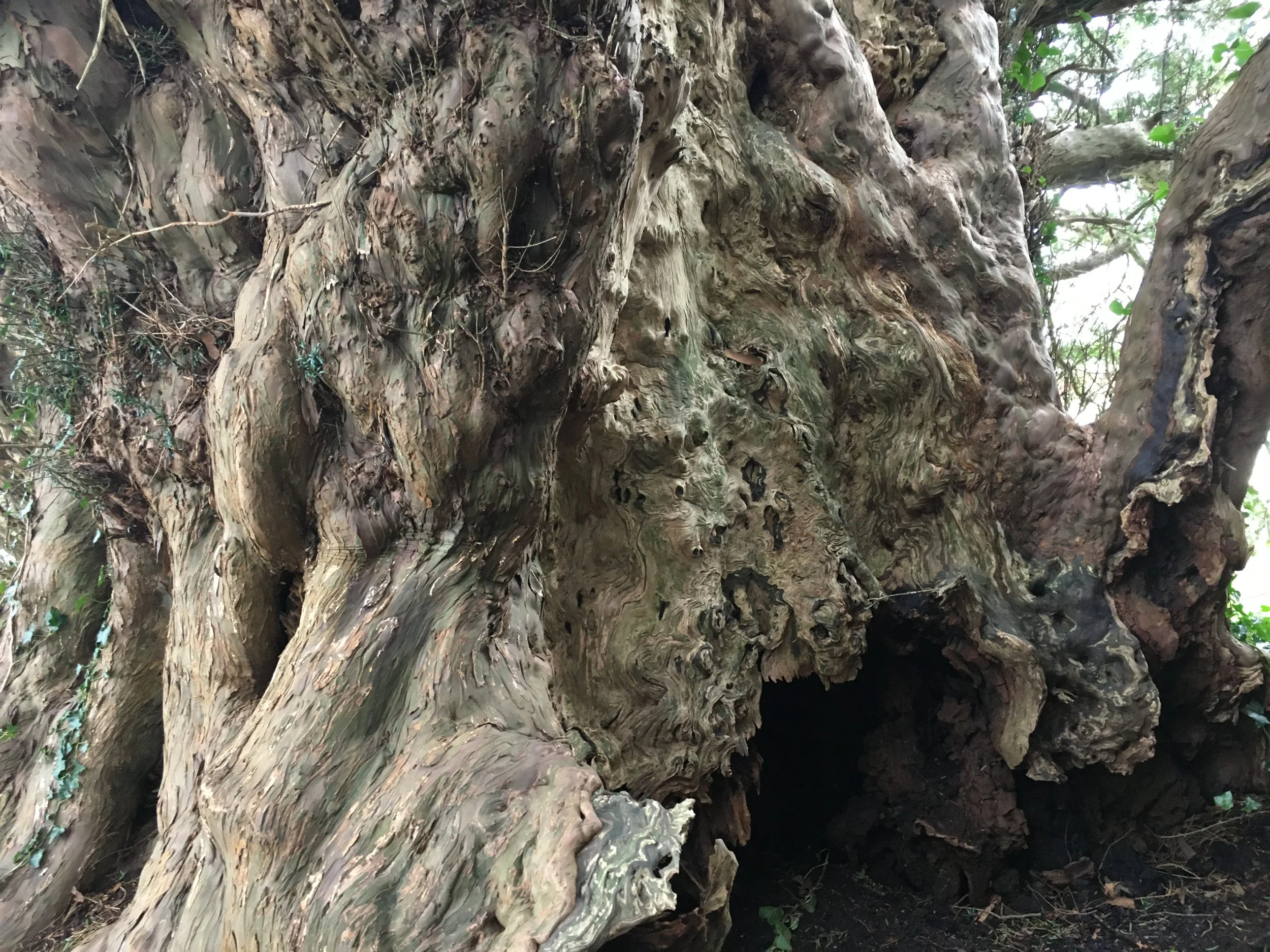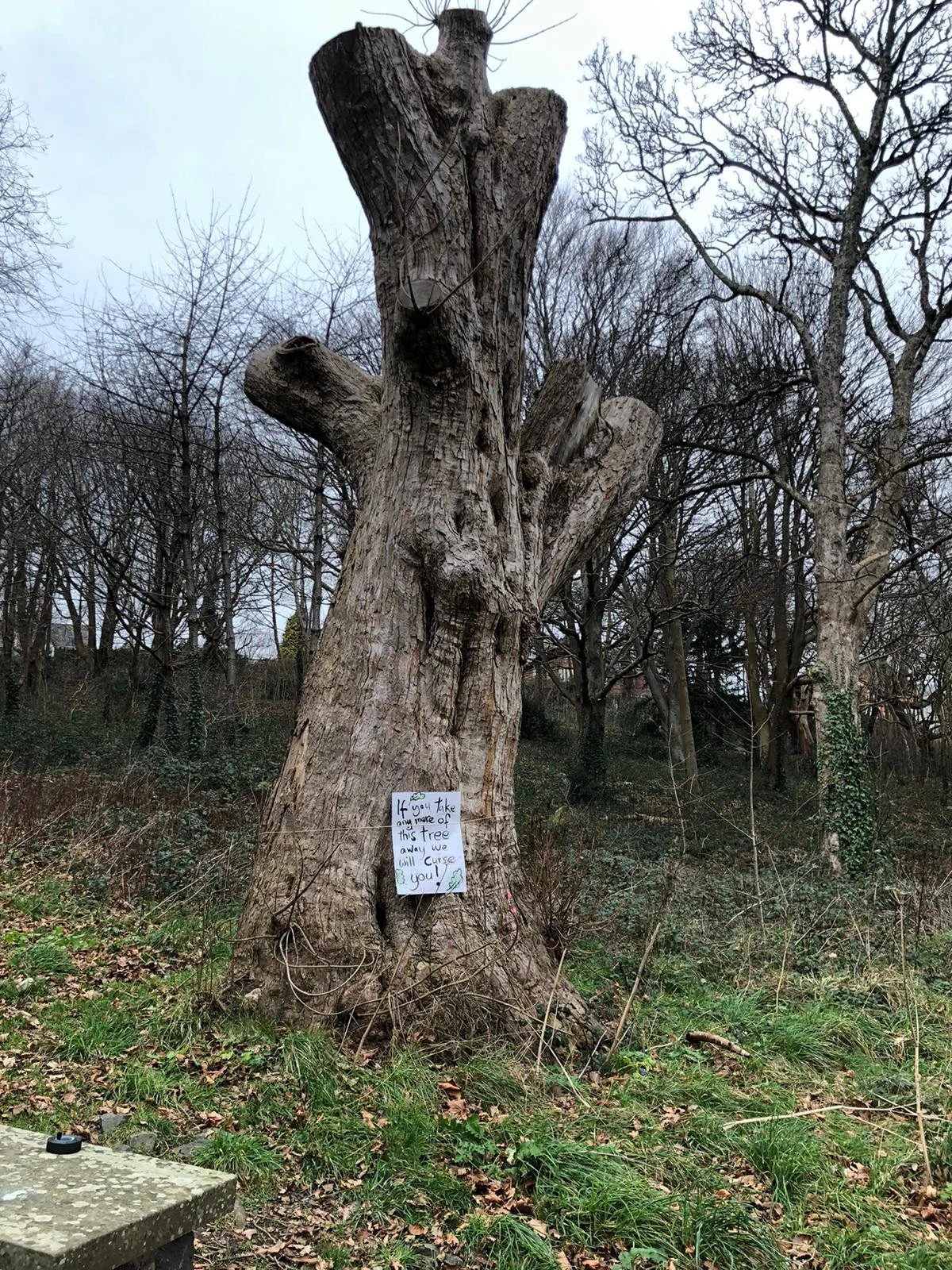Ysgol Arbrofol At Ein Coed - Treesense Experimental School @ Pontio
Cylch 4: Crone Cast a'r Hynafiaid CRONE CAST + THE ANCIENTS
Croeso i Gylch 4: Welcome to Cylch 4
During these two weeks of the Experimental Treesense School, we are hosted by Crone Cast who invite you to join us in exploring ways of reinventing becoming old woman (Crone) whilst asking the question:
“How can we become together with crones and ancient trees?”
“Sut allwn ni dyfu gyda’n gilydd gyda hen wrach a choed hynafol?”
Further information, invitations to events and resources are provided below, including audio versions of text:
For Treesense the crones are focussed on becoming ancient tree. This is the period of a tree’s life where it is most beneficial to nature and other species.
Ancient trees have passed maturity, are very old in comparison to other trees of the same species and are in the third and final stage of their life. Depending on the species trees become ancient from around 100 to 800 years old.
Trees live in symbiotic community with other species and we can join that community. We are already in that community with every breath we take and give.
Join us in imagining green futures and creating arboreal crinoline costumes for performance….
Resources and information
About Crone Cast
Crone Cast is a feminist art collective that builds on 15 years of research into becoming old woman, finding and connecting with others, human and more than human. The Crones produce a reimagined ageing female body with its accumulating inscriptions and erotic textures (Zyborska 2019).
Wanda Zyborska 2023, sketch for becoming ancient oak. Pencil ink and watercolour
For At Ein Coed the Crones are becoming ancient tree. In western culture people sometimes fear and ignore ancient trees and women. In stories old women are depicted as hags and witches, old trees and woodlands as dark, dangerous and magical places. Ancient trees are given scary faces, grasping hands and tangling roots. We are hoping that archetypal memories and connections will help us to join and become with ancient trees, exploring the complexity of our cultural history as well as the joy and richness of our becoming. The older the tree, the more vital to wildlife it becomes (Woodland Trust). Ancient oaks support at least 2,300 other species, 326 of them completely dependent on the oak. There are 115 living ancient oaks in England, and only 98 in the rest of Europe, including Wales and Scotland.
Together with ancient trees Crone Cast continues the quest for transmutation, seeking out the spaces between species, the liminal, borderline areas between the human and otherness, above and below the skin.
Crwydro Crone Cast Base Becoming, Coed Cyrnol, 2021
Crone Cast, Hagira: Dinas Dinlle 2022
Creating your costume at home
Collect materials for costumes and visual aids to becoming ancient tree. If you are attending the events at Pontio, some materials will be provided, but you will want your own that are linked to the ancient tree you have found (in real life or your imagination). Consider choosing a particular species of tree to become with, or you may choose a hybrid transformation.
Your costume could be as light as a single leaf, or you can join with the crones in full, dendritic, socially distanced attire. You could make one or more of the following:
Mask
Leaf brooch
Crown or headdress
Name badge (ancient tree name see Cylch 1 - Egino)
Staff (bring suitable branch)
Socially distanced attire (bring dress for downcycling)
Materials:
Leaves
Twigs
Bark
Clothing suitable for downcycling in natural colours, greens and browns
Something that provides ‘structure’ for crown, headdress or wide skirt eg hoops or wire, some of the Crones have used fencing wire
Materials that suggest leaves or bark
Safety pins, sewing kits, string, tape.
You may also like to develop your ‘tree voice’, with this short introduction by Anna Powell.
List of tools for becoming crone and ancient tree by Wanda Zyborska
This is a toolbox of ‘more or less useful instruments’ (David Garland) to aid the imagination in becoming.
Monumentalism
Basically, monumentalism is making yourself look big. Like a statue only moving. Trees embody this quality with grace and beauty, engendering respect and love. You can develop monumentality by standing on something to make yourself taller, lifting your chest and adopting statuesque poses, and putting yourself in the foreground of photos taken from a low angle. Move slowly and weightily in order to resonate with the power associated with memorials to old men.
Monumentalism comes from within. Imagining yourself taking up space and being big and strong gives you an energy that helps get you noticed. People will move out of your way rather than ignoring you. Trees are naturally monumental. Becoming with tree you can move yourself upwards into the canopy and spread your branches into the wind.
Monumentalism ‘symbolically redeems the diminishing that may come with time’ (Anca Cristofovici).
Polarities
Polarities are about avoiding black and white thinking of right and wrong, and holding unexamined values. By questioning fixed beliefs and trying to understand differences we can build the flexibility to make the imaginary take shape. This tool is particularly useful for collaborating with others especially the more than human. The opening out of energies enables expression.
Polarities help us re-think binaries such as old/young, ugly/beautiful, irrational/rational, visible/invisible. You might ask which of these is seen as positive or negative in our culture? Which is given more importance? Are they gendered?
Becoming is always developing and unfolding, a materially led state that reflects the changes in the body, both real and imagined. Polarities help us understand the creative process between the imaginary and the real.
Monster beauty
We ask why the representation of old women as desired or desiring seen as grotesque or taboo? We demand to be seen and heard, and to receive equality of treatment together with ancient trees.
We ask what is it to be inhabiting skin when it is deteriorating and wrinkling, covered in bark that may be scored with graffiti or rotting and bored by woodpeckers? How does it feel, and how can we have fun with it? Explore the inscriptions and transformations brought about by ageing as alternative beauty (Rocio Boliver).
How does one live within yet live against a society in which the perfect picture of beauty thrives? The answer is ‘monster beauty’…an aesthetic/erotic aptitude, fleshed out and inspirited with the essence of Aphrodite.’ (Joanna Freuh)
We invite you to root out the belief that you are not tree, and feel the sap rising under your erotic textures of bark and leaf in your arboreal transformation.
The Contract
Seeing someone enact very different performances of gender, age and species can help people question their own norms and the values they have been taught by society and parents, the ‘social contract’. This can give an insight into the mutability of gender, beauty and ageing. You are invited to blur the distinction between reality and imagination, nature and artifice, tree and woman to become an art-making assemblage.
When we disguise ourselves as trees and cover ourselves with leaves and bark it might make women question why they want their breasts lifted and enlarged and their foreheads frozen.
Imaginary collaboration
Imaginary collaboration came out of thinking about working with art and artists from the past, long dead. To me it seemed almost identical to collaborating with living people. I benefitted from imaginary conversations that made me do things I would never have done without meeting these artists and their work. I was changed and enriched by the relationships, and so was my art.
Imaginary collaborations extend our relationships in time and space. We can develop our radical imagination by learning from the past as well as from other species and the non-human. Each time we practice these imaginative expressions we expand our imaginative boundaries and skills in visualisation and transformation.
The Tactile
For me all art originates from an encounter with something in the world:
Something in the word forces us to think. This something is an object not of recognition but of a fundamental encounter (Deleuze).
These encounters with the world and with art are transformational. We are changed by them. The performative body has a potential to ‘destabalise the structures of conventional art history and criticism’ (Amelia Jones). The structures of art, politics and the media result in aestheticized violence and lack of accountability where the inertia of the tradition keeps desensitising us to the issues.
If Surrealism is directed at the restoration of universal powers of irrational thought, emotion and perception, then Svankmajer sought to demonstrate that tactile experience, as poetry, restores access to them (Cathryn Vasseleu).
Imagining oneself as ancient tree could be seen as a Surrealist encounter of a tactile nature. It is in this area of openness to the unknown, stimulated by the interaction with the collaborator, that possibilities for new ideas, transformations and becomings are found.
Wanda Zyborska
Llun: Wanda Zyborska
People creating Cylch 4: Crone Cast + The Ancients
Crone Cast: Wanda Zyborska (coordinator), Lisa Hudson, Lindsey Colbourne, Kar Rowson, Steph Shipley, Rhona Bowey, Emily Meilleur
Cerddi’r Coed Tree Poetry is created by the Utopias Bach Poetry Group, coordinated by Iain Biggs and Elinor Gwynn, with Steph Shipley, Wanda Garner, Siân Shakespear, Lisa Hudson, Lindsey Colbourne, Audrey West, Anna Powell, Wanda Zyborska.





























